My mom is a big fan of her bedside commode, which has hardly ever been by the bed, but has been used all over the house, as a chair, a bedside commode, a raised toilet seat (pretty much permanently) and also a sponge bath chair. Bedside commodes are very versatile and come in a variety of types, some with more specialist uses than others.
There are four main types of commode chair – (1) portable bedside commodes, (2) drop arm commodes, (3) transport or rolling commodes, (4) shower chair and transport commodes. Each of the basic types can have variations depending on the weight of the user, whether the commode folds up, and the types of upholstering applied to it.
Commode chairs are also called bedside commodes, or portable commodes.
There are all sorts of commode chairs, some with wheels, some for the shower, some for the bedroom, some which fold up, some with one function only, and others which can be used in multiple situations, and as such the designs can also be quite different, but all resemble some type of chair.
Contents Overview & Quicklinks
What does a commode chair or bedside commode do ?
When should you start using a bedside commode ?
Types of bedside commode, or commode chair – 4 main types
Shower chair and bedside transport commodes
Armchairs with built-in commodes
Where to buy a bedside commode ?
How to choose a bedside commode ?
How to sit on a toilet after hip surgery ?
What does a commode chair or bedside commode do ?
Commode chairs, or bedside commodes, are portable toilets which do not have running water, so they do not flush.
You can place them wherever they are needed in the home.
You can either use disposable bags which line the commode bucket and which are quickly, and easily, disposed of without any clean up of the bucket required, or if you prefer you can empty the contents down the toilet, and then wash and disinfect the bucket after.
When should you start using a bedside commode ?
Typically, bedside commodes are used by patients post surgery, the elderly, or by disabled individuals who require a toilet by the bed, or near to them in another room, due to mobility and safety issues.
A person who cannot stand, and may require a commode next to the bed, which they can slide over onto without standing. In this case, it would be a transfer commode, of the same type a person in a wheelchair would also use.
If a person is not able to slide themselves over, or to stand, a caregiver can use a patient lift to place them onto the bedside commode, if it is safe to do so.
Often a commode is placed by the bed, or in a living area, simply because the user is not able to get to the toilet quickly enough. This may be due to mobility, or incontinence issues, and helps to avoid accidents.
It is a good idea, in many cases, to have a bedside commode next to the bed for elderly adults, so they can avoid taking walks to the bathroom at night.
It helps to reduce falls due to a lack of lighting, drowsiness, confusion and from stiffness from lying in bed.
My mom can be incredibly stiff when she gets up to go to the bathroom at night, and this can lead to her being somewhat unsteady.
Should you wish to find out more, you can take a look at this article – “When Should You Start Using A Commode ?”.
Benefits of bedside commodes
My elderly mom has been using a bedside commode over our toilet for a number of years, and to say she is happy with it is an understatement.
The bedside commode gives us both peace of mind at night, knowing that Mom has an easy and safe way of using the toilet, which makes it easier for her to sit and stand.
For a person with reduced mobility, a bedside commode can be of great benefit, and not just because it makes the sitting and standing more comfortable by adjusting the height of the seat.
The Benefits can be –
- safety
- creates greater independence, freedom and control for the user
- can lead to increased privacy and sense of dignity
- easy and quick access
- wheelchair users may find it easier than a toilet in certain situations
- comfortable option for bedridden individuals, as compared to a bed pan
- can increase user confidence once they see how it makes sitting and standing simpler
- they are height adjustable, which means you can get the seat higher
- models in all sizes, including for larger individuals
- low-cost option – they start at around $40.00
- no need for home renovation
- can be placed anywhere in the home
- extremely portable
- models with wheels
- some models have multiple uses
- certain models can be used over an existing toilet
- a safe option after hip or knee replacement surgery for raising the height of a toilet seat
To learn more about the benefits, and especially to our elderly loved ones, you can take a look at my article on the many ways in which it can really help – “19 Benefits Of Bedside Commodes: Making Life Easier For Seniors”
Types of bedside commode, or commode chair – 4 main types
The four main types of bedside commodes, or commode chairs, are –
- bedside/portable commodes
- drop arm bedside commodes
- transport or rolling bedside commodes
- combination shower chair, transport chair and bedside commodes
I don’t want to make this too confusing, but you will see the four basic types being mixed up a little, i.e. you may get a transport, or rolling commode, with drop arms, or a shower or transport commode with drop arms.
These four main types of commode can all come as –
- “bariatric” or “heavy duty” commodes for larger individuals
- “lightweight” commodes for smaller people
- “folding” commodes for those who like to put them away easily
- “padded” commodes for individuals who don’t like harder plastic seats
- “extra wide” commodes are also available in the 4 main types as well
I have an article where I list the weight capacities of all the raised toilet seats and bedside commodes that I have been able to find, which includes over 180 different models, and amongst them many bariatric bedside commodes. You can find that article here. I am constantly adding to the list of raised toilet seats and bedside commodes, to keep it as up to date as possible.
I have listed lots of examples of all the different types of commodes below with my description of each of the four main types, with their model number and their weight capacities.
If you are not sure what a bariatric commode is, you can find out all about bariatric commodes here – “What Is A Bariatric Commode ?”. The article lists all the types of commode have bariatric versions, and the different features which can be found on bariatric commodes, and which are generally not found on other models.
Bedside commodes – portable
Portable bedside commodes come is several basic types –
- static folding – folds like a chair
- static stacking, which does not fold at all
- static shower and bedside commode, which may or may not fold
- static 3 in 1 bedside commode
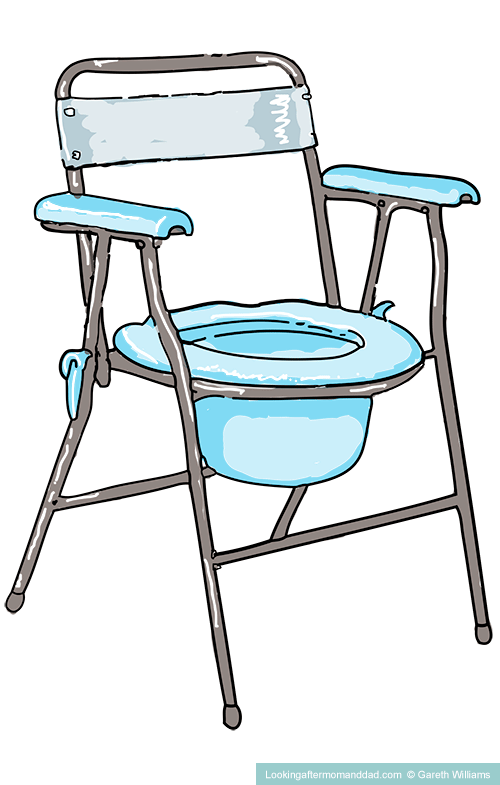
Static folding bedside commode
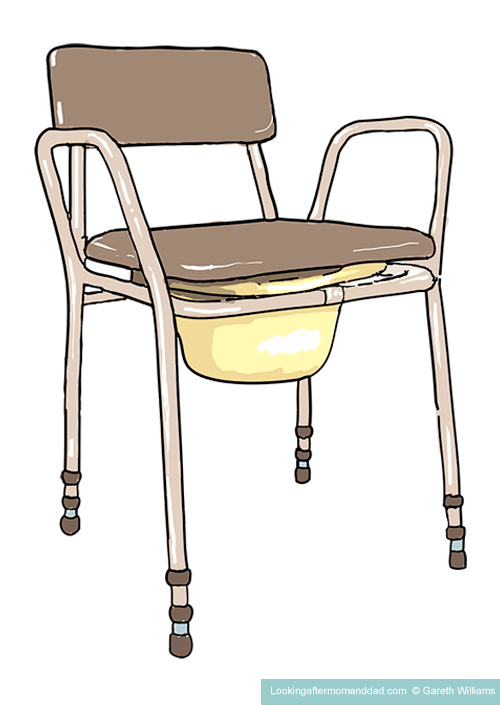
Static stacking bedside commode
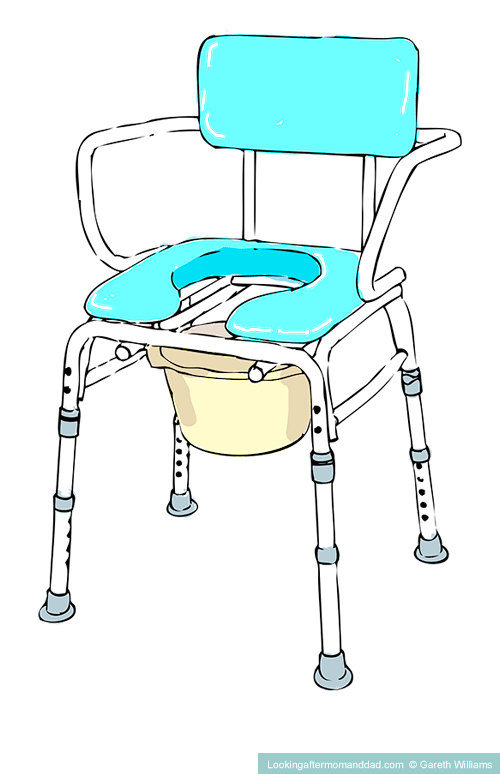
Static shower bedside commode
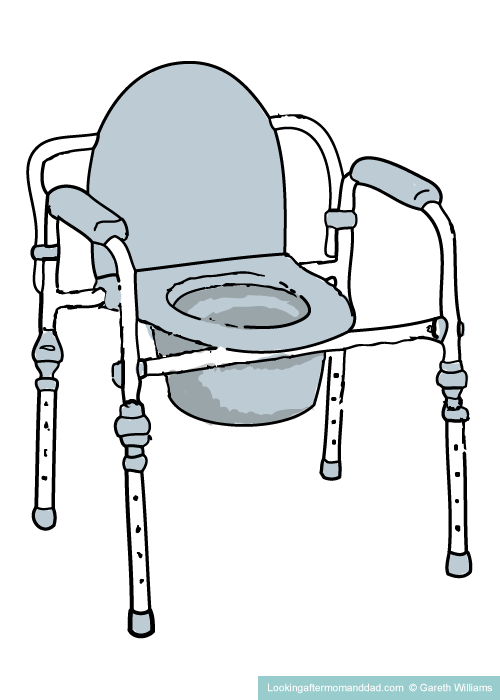
3 in 1 bedside commode
The portable bedside commode is the most commonly used type of commode, and is a static chair with a lid, a toilet seat, and a commode bucket, potty or pale.
They should come with a splash guard as well, if they can be used over the toilet.
The 3-in-1 bedside commode is the most versatile of these 4 types with 3 intended uses – hence the name 3-in-1 commode – as
- a bedside commode
- a raised toilet seat for over the toilet (without the bucket)
- as a toilet safety frame around a toilet (if you remove the seat, lid and bucket)
The frames usually come in steel, or aluminum, while the seats are either a hard plastic, or padded.
Just because the 3-in-1 bedside commode has three intended uses, this does not mean that it cannot be used for more.
For my mom, I had her to sit on it for a partial sponge bath – but keep it dry.
If your commode is made of steel and has any parts which could rust you shouldn’t do this, so it’s best to do this with aluminum alloy commodes which are stated to be waterproof.
The highest seat on a bedside commode is on the TFI Extra Tall bedside commode, made by TFI Healthcare. This commode’s seat height can be adjusted from 19″ – 28″.
So, even the “Convenient Height Extra Tall Toilet” with its rim at 20″ from the floor, coupled with a 6″ raised toilet seat, is 2″ less than the “TFI Extra Tall Bedside Commode.”
I put this in here to save time for those of you who are very tall, as the TFI Extra Tall Bedside Commode is the tallest option.
As this is the most flexible type of bedside commode, you may want to find out more. I have two articles which will tell you all you need to know –
“What Is A 3-in-1 Commode ? And What Is It Used For ?”
“3 In 1 Bedside Commode Weight Limit Guide: With Over 50 Examples”
Bedside or portable commode examples –
220 lb – Lattice folding bedside commode, Prod. No. Unavailable
260 lb – Elite Care lightweight folding commode, Prod. No. ECCOM1
28o lb – ZXXX folding bedside commode, Prod. No. YS-300
300 lb – Carex folding bedside commode, Prod. No. B341-00
340 lb – Aidapt Essex height adjustable commode, Prod. No. VR161G
350 lb – Drive Medical steel folding bedside commode, Prod. No. RTL11158KDR
375 lb – Aidapt Essex height adjustable commode, Prod. No. VR161
400 lb – Lumex imperial collection 3-in-1 bedside commode, Prod. No. 7446A-2
450 lb – Probasics heavy duty Wide Commode, Prod. No. BSB31C
500 lb – Nova heavy duty commode w/ extra wide seat, Prod. No. 8582
545 lb – Aidapt Sussex bariatric commode, Prod. No. VR221
650 lb – Drive Deluxe bariatric commode, Prod. No. 11130-2
700 lb – Performance Health heavy-duty commode w/ elongated seat, Prod. No. 081261767
800 lb – Big John Commode chair, adjustable legs, Prod. No. BJBC
Drop arm bedside commodes
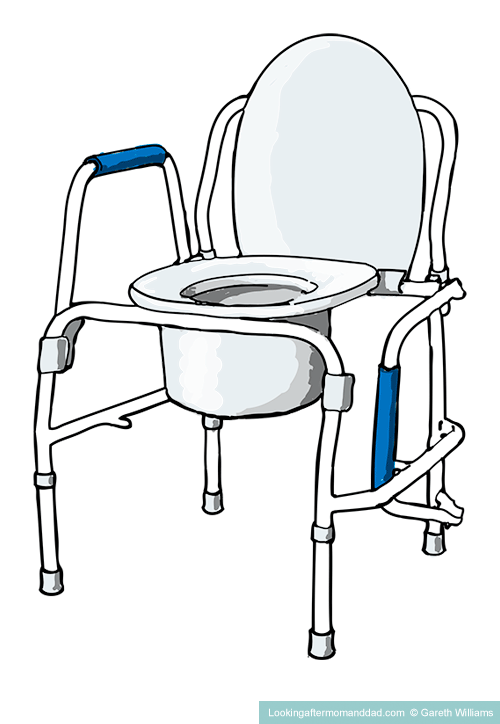
Static drop arm bedside commode
As the name suggests, these bedside commodes have drop armrests which can be moved out of the way if the user needs to slide out of the side of the chair into a wheelchair, for instance.
Drop arm models may also be referred to as transfer commodes as the user can transfer out of the side to a wheelchair, or a low bed.
The drop arm model can be very practical if the person using the seat needs some help cleaning themselves, as a fixed arm may get in the way.
The drop arm can be dropped away, so the caregiver can stand on the side and give help from there, without being obstructed.
The drop arm bedside commodes can also be used just like the 3-in-1 commode as –
- a bedside commode
- a toilet safety frame
- a raised toilet seat over your toilet
The frames are steel, or aluminum, the seats and lids are either a hard plastic, or a padded seat on some models.
Drop arm models can be found both as static, or mobile commodes.
Are you wondering whether you should buy a drop arm commode, or a 3-in-1 commode (without drop arms) ? Well, I have you covered with another article which discusses just that – “Drop Arm Commode vs 3 In 1 Commode: There’s At Least One Big Difference”.
Drop arm bedside commode examples –
250 lb – Medline steel drop arm commode, Prod. No. MDS89668
300 lb – Drive Medical deluxe steel drop arm commode, Prod. No. 11125KD-1
350 lb – Homecraft drop arm padded commode, Prod. No. 081706399
450 lb – Tuffcare extra wide drop arm commode chair, Prod. No. M470
470 lb – Performance Health drop arm commode, Prod. No. 081299338
600 lb – Lumex 6438A imperial collection 3-in-1 steel drop arm , Prod. No. 6438A
650 lb – Probasics heavy duty drop-arm commode, Prod. No. BSBDAC
700 lb – Performance Health heavy-duty commode w/ elongated seat, Prod. No. 081261767
1000 lb – Drive Bariatric drop arm commode Prod. No. 11135-1
While you are looking for bedside commodes, there is lots more that you can do to make your bathroom a safer place for seniors, or anyone else with mobility issues.
To find out all the different things you can do, to have an instant impact on bathroom safety, take a look here, “54 Bathroom Safety Tips For Seniors – A Helpful Guide”.
Transport or rolling bedside commodes
These are bedside commodes on wheels, on which you can push your loved ones around.
The transport or rolling commode can be used as –
- a transport chair
- a bedside commode
- or placed over the toilet as a raised toilet seat
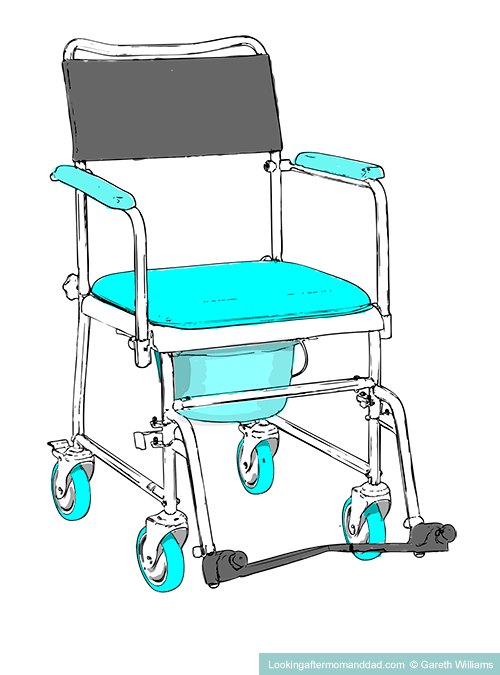
Attendant transport bedside commode
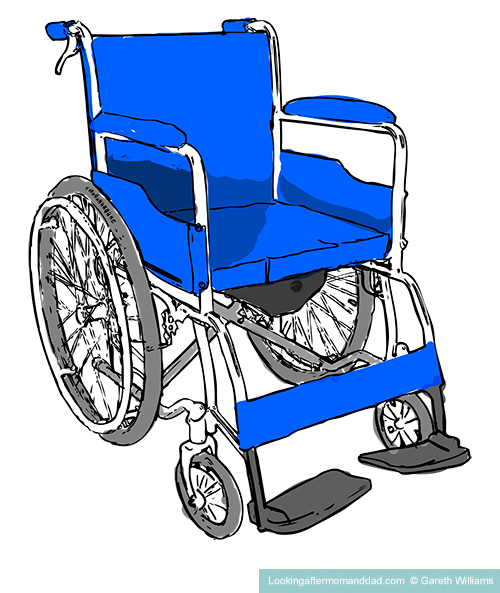
Self-propelling transport commode
If you are caring for an elderly parent, or a person with disabilities who have problems with their mobility, a transport commode can be extremely helpful.
If your loved one needs to use the commode, and there is time, you can wheel your loved one through to the bathroom toilet, and position the transport commode over the toilet.
This can help reduce odor control difficulties in a bedroom, and makes commode clean up unnecessary.
If you are hoping to be able to use your transport commode over a toilet, check if you get a fixed-height model, that it has the required height to pass over the rim of your toilet.
The transport commodes with adjustable legs will usually have an extended height range of 3 – 5″.
Always lock the wheels when using the commode in a static position, either in the bedroom or over the toilet.
Transport or rolling bedside commode examples
250 lb – Nova drop arm transport commode w/ wheels, Prod. No. 880
300 lb TFI Healthcare commode w/ elongated seat, Prod. No. 3217
310 lb – Mor Medical New Era PVC rolling commode chair, Prod. No. DNE-118-3TWL
Shower chair and bedside transport commodes
The shower transport commode can be used as –
- a shower chair
- a transport chair
- a commode
- some can also be used over the toilet as a raised seat, but you do have to check the height of these, as not all are height adjustable
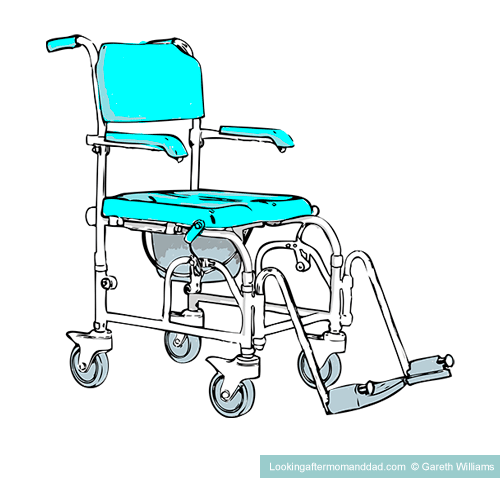
Attendant shower transport bedside commode with four small wheels

Attendant shower transport bedside commode with medium sized rear wheels
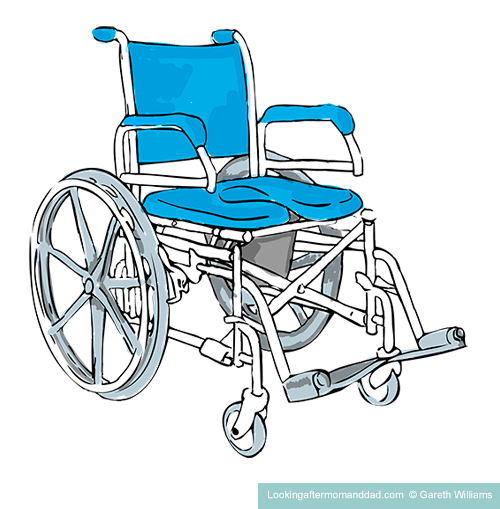
Self-propelling shower transport bedside commode
These commodes can be wheeled into the shower and have been specifically designed for this.
Of course, if your shower has a lip, shower commodes won’t go in, unless you have a model with medium or large rear wheels, so that aspect would be totally redundant.
Shower chair and bedside transport commode examples
250 lb – Nova padded commode shower chair w/wheels, Prod. No. 8801
260 lb – Tuffcare padded transport commode shower chair w/ 6″ casters, Prod. No. S900
275 lb – Drive Medical aluminum rehab commode shower chair w/ 24″ wheels, Prod. No. NRS185006
286 lb – Healthline, Ezee Life commode shower chair w/ 5″ casters, Prod. No. 150
300 lb – Invacare mariner rehab commode shower chair w/ 5″ casters, Prod. No. 689
385 lb – Mor Medical euro deluxe commode shower chair w/ 4″ casters, Prod. No. MD-118-4TL
440 lb – Healthline, Ezee Life heavy duty commode shower wheelchair, Prod. No. 186-24
450 lb – Tuffcare bariatric commode shower wheelchair w/ 24″ wheels, Prod. No. S99o
500 lb – Drive Medical bariatric rehab commode chair w/ 5″ casters, Prod. No. NRS185008
600 lb – AcveAid heavy duty rolling commode shower chair, Prod.No. 720
Armchairs with built in commodes
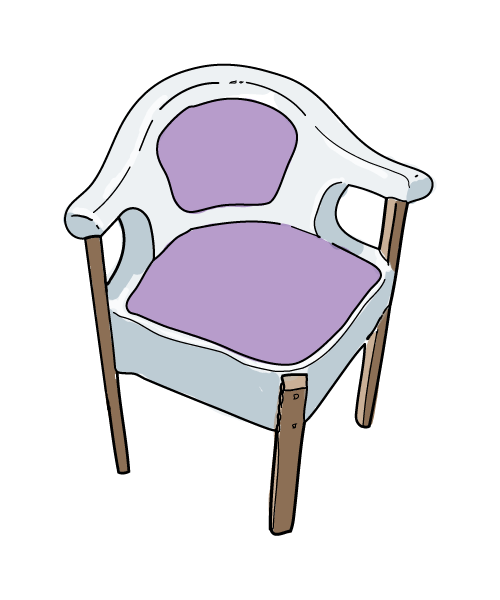
Derby Corner Commode
There is another type of commode that I didn’t list in my “types” at the beginning as they are not that common, but some people do prefer them as they look like an armchair, and so don’t draw attention to the fact that there is a toilet in the middle of the room.
If you don’t lift the cushion area of an armchair commode to reveal the built-in commode area with the pale, or potty, you would not know that it was a commode.
For someone who wants a more discreet commode which sits in a lounge or a bedroom, and which you would not suspect was a commode, then these are the commodes you should be looking at.
The commodes are made of wicker, vinyl, and washable cloths, and most often are supported by a wooden armchair frame.
There are not many models on Amazon in the US, but you can find more on eBay which can be shipped in from the UK.
The “armchair” commodes cost around $2 – $300. Certainly avoid the outrageously expensive ones, and do look on eBay, as they are available.
To find out more about armchair commodes, you can go to my article – “14 Perfectly Discreet Commode Chairs: No One Will Ever Know !”.
Armchair commode examples
264 lb – Drive DeVilbiss Healthcare (Drive Medical) Wicker Commode, Prod. No. COO8
320 lb – Aidapt Lancaster Luxury Commode, Prod. No. VR252A
350 lb – Drive DeVilbiss Healthcare (Drive Medical) Basket Weave Commode, Prod. No. Z6229
350 lb – Gordon Ellis Derby Basketweave Commode Chair, Prod. No. 5504/OA
418 lb – Gordon Ellis Walton Height Adjustable Commode Chair, Prod. No. 6288 or 6289
560 lb – Gordon Ellis Derby Corner Commode, Prod. No. 55085/BR
Where to buy bedside commodes ?
Once you have sorted out which bedside commode you wish to buy, you may find these articles of help –
“Where To Buy A Bedside Commode ?”
“Where To Buy A Bariatric Commode ?”
“Where To Buy Shower Commodes ?”
“Does Walmart Carry Bedside Commodes ?”
How to choose a bedside commode for an elderly person ?
To choose the appropriate bedside commode for an elderly person, you need to be asking yourself, and the person in involved, a number of questions –
General questions
- is the person bedridden
- will the person be transferring from the bed to the bedside commode ?
- does the person use a wheelchair ?
- how much room is there for maneuvering around the bedside commode ?
- is the person using a walker to back up and sit down on the seat ?
- what is the reason for using a bedside commode ?
- is the user very elderly ?
- what is the person’s mental condition – are they confident or nervous about using a bedside commode ?
- how confident is the user about moving backwards up to a bedside commode ?
- does the person need to have extra safety equipment to make them feel confident about using a bedside commode ?
- is the bedside commode for long term or short term use ?
- if it is for the long term, do you want to have to buy another bedside commode with a lift mechanism later, as the person gets weaker ?
Physical condition – how is the person’s physical condition ?
- are there any mobility issues ?
- what is the person’s balance like ?
- how good is their eyesight ?
- how strong, or frail, is the person ?
- how good is the person’s grip ?
- how good is the person’s coordination ?
- is the person okay cleaning themselves afterwards ?
- will the person using the bedside commode have the strength to sit back without giving the bedside commode a jolt ?
- will the person be needing padded armrests ?
- is the person overweight – will you need a bariatric bedside commode ?
- does the person have larger thighs which require an extra bedside commode ?
Medical reasons for needing a bedside commode
- if there are medical issues, which have specific requirements to be met ?
- do you need to check with the person’s doctor or nurse ?
- if they have eye conditions, do they need extra grab bars, high visibility seat and armrests ?
- is the bedside commode just for after an operation ?
- is the bedside commode for a long term medical condition, and what does that condition require ?
Asking questions like these should help you to decide what type of bedside commode is appropriate for your personal situation.
My mom uses a bedside commode over our toilet, and this is super steady and easy to use, and has the great advantage of being easy to move if you don’t want to use it – they are very light and can just be picked up and put elsewhere.
After my mom’s hip replacement she tried different raised toilet seats in the hospital, and at home, all of which locked onto the toilet bowl, and none of those without legs, or without armrests gave her any confidence. And we have used the bedside commode for her, both by the bed and over the toilet, ever since.
Don’t forget that a walker really does help the elderly to back up to the bedside commode, to sit and to stand, if they have balance issues, or are recovering from surgery.
If you wish to find out more about using bedside commodes, or raised toilet seats, after a hip replacement, I have several articles covering the subject – comparing bedside commodes with raised toilet seats –
“Best Raised Toilet Seats After A Hip Replacement”
“Best Raised Toilet Seats For Elderly Seniors: A Detailed Guide With Prices”
How to sit on the toilet after hip surgery ?
If you are reading this because you are going to be having hip replacement surgery, and you are researching topics you will need to know for your recovery, I have a number of articles all to do with hip replacement recovery, and one of which is all about sitting on the toilet after surgery, and you will find illustrations of how to sit, what height your seat should be, how long you need to wait before taking up certain activities post surgery, whether you should use a raised toilet seat or a bedside commode, and which is best for the elderly.
You can find that article here – “How To Sit On A Toilet After Hip Surgery: A Detailed Illustrated Guide”.
How to assist a person to use a commode ?
To help someone who can stand to use a commode, you need to get them standing with their back to the commode.
If your loved one is very unsteady, it’s good to have a walker that they can hold onto while they back up to the commode.
To sit down on a bedside commode –
- have your loved one back up to the commode holding the walker
- your loved one should keep holding onto the walker, so they don’t lose balance
- they should back up until they feel the commode frame touching the back of the legs
- if you’re helping your loved one, you may want to help them remove or lower any items of clothing before they sit down
- your loved one must reach back with one hand to find the armrest on the same side
- your loved one must reach for the armrest on the other side, with their other hand
- now your loved one is holding the armrests they can sit back on the bedside commode seat
- your loved one needs to not sit down too quickly, this can jolt the commode and cause it to tip
- when your loved one is seated, their feet should be as flat to the floor as possible – if their feet are in the air you need to lower the commode
To stand back up from a bedside commode –
- make sure that a walker is in front of the commode to hold onto when standing if your loved one is very unstable, or has just had knee or hip replacement surgery
- have them place both hands on the armrests of the commode, and push up to stand
- they should then reach forward with one hand and take hold of the walker and then do the same with the other hand
How to help your loved one if they can’t clean themselves –
- if your loved one is very unsteady, they may not be able to clean themselves
- it’s best to have all the provisions you need to hand before you start – you don’t want to leave your loved one standing there while you fumble around looking for things
- so you will need to have toilet paper, wet wipes and gloves
- before doing anything else, start by putting on the gloves
- help your loved one to stand and hold the walker
- help clean, or clean your loved one with the toilet paper or wet wipes
- if your loved one is a woman, it’s important to clean them from front to back to prevent UTI’s
- make sure after cleaning that your loved one is gently dried with a soft towel
- after you have helped them to dry themselves, help your loved one to put any clothes back on
- assist your loved one back into the bed
- dispose of the toilet paper and wet wipes in the outside trash
- finally, dispose of the gloves you used and wash your hands thoroughly with soap and water
Tips for cleaning a commode
To clean a frame or commode
1) Remove the armrests, the seat, the lid and the splash guard – clean each part with a non-abrasive cleaner and then rinse them off thoroughly.
2) To cut down on skin infections, it is important to clean the armrests and seat very thoroughly, as this is where your loved one’s skin has the most contact with the commode.
3) With regard to the underside of the seat, the splash guard and the frame immediately next to them, these will be the areas which get covered with urine and feces, so they will also require a thorough cleaning.
4) The cleaning should remove any marks and deposits with a non-abrasive cleaner.
5) Now clean the same parts again with disinfectant.
6) Once you have finished washing with disinfectant, you can rinse and dry the different elements that you have removed.
7) Repeat the whole process for the frame, and put back the seat and lid on the frame.
8) Remember to regularly check the plastic of the seat for any cracks and make sure that there is no rust in the joints of the commode frame to avoid any accidents.
9) If there are plastic joints, have a good look to make sure they are not cracking. Anything with cracks should be replaced.
10) Make sure to check the ferrules – the rubber tips of the legs – for splitting, as when they split they will no longer grip the floor as the metal will come through, and will skid on the floor if it is not carpeted.
I can personally attest to this, as the tips on my crutches split and I went flying as the metal of my crutch skidded on the shiny floor I was walking on.
It is going something similar with a commode when someone sits down or stand up, and they could hurt themselves if the commode skids backwards.
The ferrule does have a metal washer at the bottom to stop the metal splitting the ferrule, but as in my case, they sometimes don’t work.
So keep an eye on that. You can easily find and buy “ferrules” online.
To learn more about using abed side commode, you can read my article, “Using A Bedside Commode: An Illustrated Guide”, which discusses –
- Where to position a bedside commode ?
- What supplies are needed next to the commode for after use ?
- How to stop a commode from tipping ?
- Bedside commode liners
- How to prepare the commode pail if you are using commode liners ?
- How to prepare the commode pail if you are not using liners ?
- How to empty and clean a bedside commode ?
- Bedside commode odor control
- How to transfer to a bedside commode ?
- How to assist someone using a bedside commode ?
How to set up a bedside commode over a toilet ?
Quite a few bedside commodes can be used as a raised toilet seat.
- 3 -in-1 commodes
- drop arm commodes (if they are a 3-in-1 commode)
- stacking commodes
- transport commodes
- shower transport commodes
This does not mean that every model of each of these types of commode will fit over your toilet.
You have to measure your toilet bowl rim height, and then see if the seat height of the commode of your commode of choice will clear that – *** if it is a commode design where the commode bucket slides in from the front into a rail on either side, you will want to add at least an inch and a half to the height of your toilet rim, to get the height correct measurement.
If you are unsure, I would measure the height of your toilet bowl rim from the floor and ask a supplier.
***With some shower and transport bedside commodes there is a horizontal bar crossing between the back legs of the design quite close to the floor, and this type will not fit over a toilet as this bar is fixed. So again check with the supplier before you buy one.
You will find bariatric models of each type for larger individuals.
To set up a bedside commode over a toilet –
- take the commode bucket/pale out of it’s holder
- check the height of the legs, so they raise the seat to the appropriate height
- put your toilet seat and lid into the upright position, or if you want to, remove them completely, but it’s usually not necessary
- place the commode over the toilet
- lift the seat of the bedside commode and drop the splash guard into place
To learn more about using a bedside commode over a toilet, you can just click on this link to “Can A Bedside Commode Be Used Over A toilet ?”.
You will find a complete list of bedside commodes that you can use over a toilet, with the model name and number, plus the maximum seat height of that commode, and all organized by height –
- 25 inch seat height
- 24 inch seat height
- 23 inch seat height
- 22 inch seat height
- 21 inch seat height
- 20 inch seat height
- 19 inch seat height
There is more information about where to buy the commodes, how much they cost, and also a comparison with the different types of raised toilet seat.
I’m Gareth, the author and owner of Looking After Mom and Dad.com
I have been a caregiver for over 10 yrs and share all my tips here.

